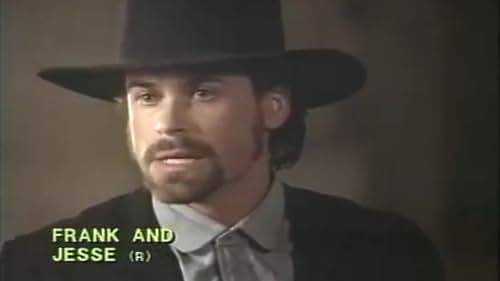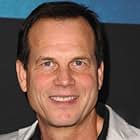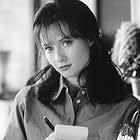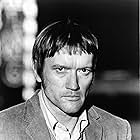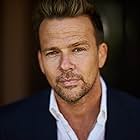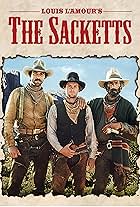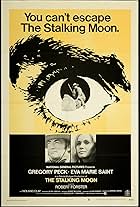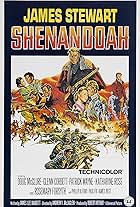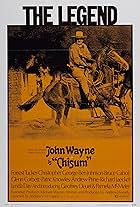IMDb RATING
5.8/10
1.7K
YOUR RATING
Western starring Rob Lowe and Bill Paxton, based on the lives of Frank and Jesse James. After the Civil War Frank and Jesse return to their family's farm. When their younger brother is murde... Read allWestern starring Rob Lowe and Bill Paxton, based on the lives of Frank and Jesse James. After the Civil War Frank and Jesse return to their family's farm. When their younger brother is murdered they embark on a mission for revenge.Western starring Rob Lowe and Bill Paxton, based on the lives of Frank and Jesse James. After the Civil War Frank and Jesse return to their family's farm. When their younger brother is murdered they embark on a mission for revenge.
Nicholas Sadler
- Arch Clements
- (as Nick Sadler)
- Director
- Writer
- All cast & crew
- Production, box office & more at IMDbPro
Storyline
Did you know
- TriviaEven though, in the film, Jesse's home is shown as a big two-story house, the original house is in fact much smaller and was located in town. However, the actual house still stands, but has been moved three times to its current location, next to the Patee House in St. Joseph, Missouri. The final scene with Jesse, the chair and picture is exactly how it happened according to Bob Ford. In the original house, there is still a dent and blood stain on the floor where Jesse fell.
- GoofsJesse would not be standing taking the oath of fidelity to the union, he was shot in the chest trying to surrender and was bedridden for months.
- Quotes
Frank James: Hell of all the things I lost, I miss my mind the most.
- ConnectionsReferenced in Buttcrack (1998)
- SoundtracksAuld Lang Syne
Performed by Randy Travis
Featured review
First of all, let me agree with the reviewer from Kansas City that if you want a historically accurate film about the James brother see "The Assassination of Jessie James by the Coward Bob Ford" based on the book by Rob Hanson. All other Jesse James movies are terribly inaccurate and misleading.
At the end of "Frank & Jesse" is the disclaimer: "This motion picture is based upon actual events. However, some of the characters and incidents portrayed and many of the names used herein are fictitious; any similarity of such character, incident, or name, to the name, characters or history of any person, whether living or dead, is entirely coincidental and unintentional."
Many of the events never happened. For example, Pinkerton and Jesse were never known to be in the same place at the same time The hilarious bathhouse romp and the shooting at the ferry involving the wives, Anne and Zee, resp. give a whole new meaning to "Mollification".
Then there's the legend of the widow's mortgage. It's also attributed to Jesse's contemporary, Billy the Kid, as well as to Dick Turpin much earlier. The usual story has the outlaws repaying the widow's hospitality with cash for the mortgage and then waylaying the collector to retrieve the payment. The version in the movie is botched. A receipt is not obtained and the outlaws back off.
Some of the incidents are time shifted to earlier dates to create more sympathy for the outlaws. Their step-father was harassed, but not killed, to try to find out where Frank and the border ruffians were hiding. The revenge fire bombing, which killed their young half-brother and severely wounded their mother, occurred nine years after the war and well after the gang had robbed several banks and trains and killed many innocent people. Clemency was never granted because of these deeds and their participation in atrocities under Quantrill and "Bloody" Bill Anderson.
Most of the names used in the movie belong to actual people – but are often used incorrectly. As pointed out in earlier reviews Archie Clements died during the war. And the roles of the Fords are twisted. Was that deliberate to warn us that the details of the assassination were also being twisted to make Jesse appear to be more noble than he was?
But on to the event with which I'm most familiar, viz. the attempted robbery of the Northfield bank. Please see the Wikipedia account which is as accurate as any. There were eight in the gang – Frank and Jesse; Cole, Bob and Jim Younger; as well as Charlie Pitts, Clel Miller and Bill Chadwell. The movie has six - Frank, Jesse, Cole and Bob, and also John Younger and Archie Clements, both of whom had been dead for some time. In fact, they were armed with four to six revolvers each which they wore under their dusters, but no rifles.
There was no conspiracy. At least three movies have a conspiracy. Had there been one the defenders would have been better prepared. However, almost as soon as the raid began the locals were alerted and picked up two civil war single-shot rifles and several "fowling pieces" loaded with bird shot. Despite the fact that they are great movie clichés, nobody and no horses crashed through windows and nobody was up on the roof so they could get shot off the roof falling forward into the street. The defenders did out shoot the professionals; Miller and Chadwell received fatal wounds from the rifles. Two locals were killed – one of the bank clerks and a recent Swedish immigrant, deaths attributed to a James and Cole, resp. Both victims were unarmed.
Beside clichés we have stereotyping in the movie. Minnesota = cold; right. Snow on the ground in early September? That's two months early. And fresh ice in the ice house three months early. O'Malley Saloon and the Oslo Theatre? No way; the town was owned by Yankees from New England. Although Scandinavians and a few Irish had started to arrive they hadn't yet worked their way onto Division Street.
Posses were formed after the raid, but the James brothers were able to steal a succession of fresh mounts and rode through Dakota Territory and disappeared for three years, mainly in Nashville. Cole stayed behind to care for his brothers who were more seriously wounded. In a shoot out at Hanska Slough, seven members of a posse flushed the gang out of hiding and out shot them. Pitts was killed. The Younger brothers were captured, confessed and were imprisoned.
The movie does scratch the surface to the question "Why was Jesse the way he was?". A greater question is "Why do we try to make heroes out of murderers?" The problem with movies like "Frank & Jesse" is that they perpetuate the myth that they were some kind of Robin Hoods. If you're looking for heroes consider Joseph Lee Heywood, the acting cashier who gave his life protecting the city, and Northfield citizens A. R. Manning and Henry Wheeler and the seven members of the Madelia posse who put the end to the gang of notorious cutthroats.
At the end of "Frank & Jesse" is the disclaimer: "This motion picture is based upon actual events. However, some of the characters and incidents portrayed and many of the names used herein are fictitious; any similarity of such character, incident, or name, to the name, characters or history of any person, whether living or dead, is entirely coincidental and unintentional."
Many of the events never happened. For example, Pinkerton and Jesse were never known to be in the same place at the same time The hilarious bathhouse romp and the shooting at the ferry involving the wives, Anne and Zee, resp. give a whole new meaning to "Mollification".
Then there's the legend of the widow's mortgage. It's also attributed to Jesse's contemporary, Billy the Kid, as well as to Dick Turpin much earlier. The usual story has the outlaws repaying the widow's hospitality with cash for the mortgage and then waylaying the collector to retrieve the payment. The version in the movie is botched. A receipt is not obtained and the outlaws back off.
Some of the incidents are time shifted to earlier dates to create more sympathy for the outlaws. Their step-father was harassed, but not killed, to try to find out where Frank and the border ruffians were hiding. The revenge fire bombing, which killed their young half-brother and severely wounded their mother, occurred nine years after the war and well after the gang had robbed several banks and trains and killed many innocent people. Clemency was never granted because of these deeds and their participation in atrocities under Quantrill and "Bloody" Bill Anderson.
Most of the names used in the movie belong to actual people – but are often used incorrectly. As pointed out in earlier reviews Archie Clements died during the war. And the roles of the Fords are twisted. Was that deliberate to warn us that the details of the assassination were also being twisted to make Jesse appear to be more noble than he was?
But on to the event with which I'm most familiar, viz. the attempted robbery of the Northfield bank. Please see the Wikipedia account which is as accurate as any. There were eight in the gang – Frank and Jesse; Cole, Bob and Jim Younger; as well as Charlie Pitts, Clel Miller and Bill Chadwell. The movie has six - Frank, Jesse, Cole and Bob, and also John Younger and Archie Clements, both of whom had been dead for some time. In fact, they were armed with four to six revolvers each which they wore under their dusters, but no rifles.
There was no conspiracy. At least three movies have a conspiracy. Had there been one the defenders would have been better prepared. However, almost as soon as the raid began the locals were alerted and picked up two civil war single-shot rifles and several "fowling pieces" loaded with bird shot. Despite the fact that they are great movie clichés, nobody and no horses crashed through windows and nobody was up on the roof so they could get shot off the roof falling forward into the street. The defenders did out shoot the professionals; Miller and Chadwell received fatal wounds from the rifles. Two locals were killed – one of the bank clerks and a recent Swedish immigrant, deaths attributed to a James and Cole, resp. Both victims were unarmed.
Beside clichés we have stereotyping in the movie. Minnesota = cold; right. Snow on the ground in early September? That's two months early. And fresh ice in the ice house three months early. O'Malley Saloon and the Oslo Theatre? No way; the town was owned by Yankees from New England. Although Scandinavians and a few Irish had started to arrive they hadn't yet worked their way onto Division Street.
Posses were formed after the raid, but the James brothers were able to steal a succession of fresh mounts and rode through Dakota Territory and disappeared for three years, mainly in Nashville. Cole stayed behind to care for his brothers who were more seriously wounded. In a shoot out at Hanska Slough, seven members of a posse flushed the gang out of hiding and out shot them. Pitts was killed. The Younger brothers were captured, confessed and were imprisoned.
The movie does scratch the surface to the question "Why was Jesse the way he was?". A greater question is "Why do we try to make heroes out of murderers?" The problem with movies like "Frank & Jesse" is that they perpetuate the myth that they were some kind of Robin Hoods. If you're looking for heroes consider Joseph Lee Heywood, the acting cashier who gave his life protecting the city, and Northfield citizens A. R. Manning and Henry Wheeler and the seven members of the Madelia posse who put the end to the gang of notorious cutthroats.
- How long is Frank & Jesse?Powered by Alexa
Details
Box office
- Gross US & Canada
- $50,004
- Gross worldwide
- $50,004
- Runtime1 hour 45 minutes
- Color
- Sound mix
- Aspect ratio
- 1.85 : 1
Contribute to this page
Suggest an edit or add missing content


